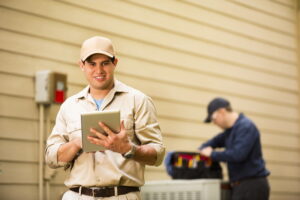Heat pumps are a fantastic choice for home comfort. They’re efficient, cutting your electric bill and your carbon footprint. They’re very effective at cooling your home in the summer, and they’re unique in that they can also heat your home in the winter!
But if that versatility is lost, you’re not actually getting the main benefit of having a heat pump. Sometimes, a heat pump can get stuck in one mode, and you’ll find it trying to heat your home when you need it cooled. What went wrong? We’ll explain.
How Heat Pumps Work
You might be familiar with the way that traditional air conditioners operate. The compressor, located in the outdoor unit or condenser, is the component which pressurizes the refrigerant, which forces it to circulate through the coils. The evaporator coils, in the indoor unit, allow the refrigerant to absorb heat inside your home. As the refrigerant warms up, it evaporates into a gaseous state. The refrigerant continues flowing, out into the condenser coils, where the heat dissipates from the refrigerant and condenses into liquid form again.
Heat pumps work in exactly this way, with one special trick: the flow of the refrigerant can be reversed. When it’s in heating mode, the refrigerant absorbs warmth from outdoors and releases it indoors. Even when the outdoor temperature is quite chilly, it’s able to do so efficiently. This is because the outdoor air does not have to be warmer than the indoor air in order for the heat pump to warm your home—it only has to be warmer than the cold refrigerant.
How Refrigerant Flow Is Reversed
In order to carry warmth in the opposite direction, a heat pump contains a specialized component called a reversing valve. Imagine a short section of metal tubing from which three tubes branch off, all along one side. It looks like a trumpet’s three valves. Inside that tube is a sliding piece that covers either the first and middle tube, making a complete circuit between those two, or the middle and last tube, closing those off to make them into a loop. With the slider in one position, refrigerant flows in the direction that provides cooling, and with it in the other position, the flow provides heating.
What Causes the Slider to Slide
The slider’s position is determined by pressure, and that pressure is created by a solenoid, a type of electromagnet in the shape of a coil. When an electric charge passes through the solenoid, it pushes the slider into the position that causes the refrigerant to flow in the direction that provides cooling. Without the electric charge, the slider sits in heating position. So if your heat pump is stuck in heating mode, it’s because that slider isn’t receiving the pressure it needs in order to slide.
Three parts must work properly to apply that pressure: the thermostat, the solenoid, and the electrical connection between the two. If your heat pump in Skokie, IL won’t cool your home, a qualified AC technician can determine where the problem lies within that chain of three possible issues. It might be a huge problem when you can’t get your house cool, but it’s a straightforward issue to repair, so don’t hesitate to get the help your heat pump needs.
Contact ServiceMax to schedule heat pump repair or ask any heating and cooling questions.
